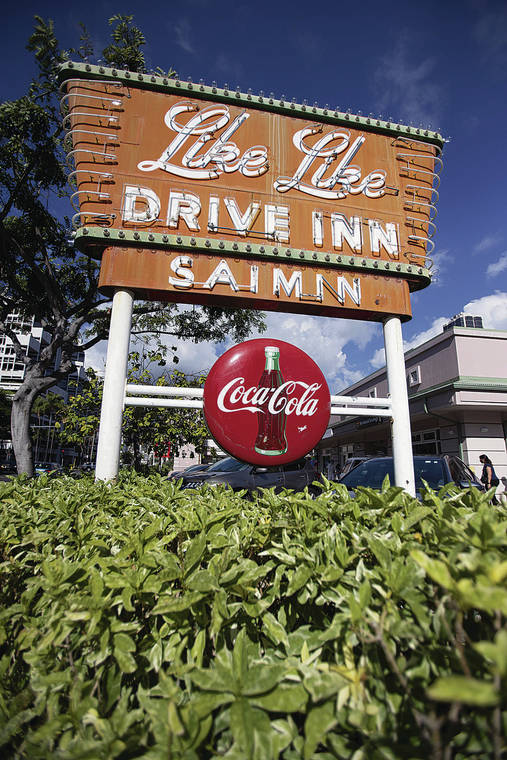Lagging tourism could lead to majority of Hawaii’s eateries shuttering by April, survey says

CINDY ELLEN RUSSELL / CRUSSELL@STARADVERTISER.COM
The Like Like Drive Inn sign remains along Keeaumoku Street but the restaurant closed in April due to the coronavirus pandemic after 67 years of business.
More than half of Hawaii restaurants may be forced to close for good by April without a significant boost in tourism, according to a survey by the University of Hawaii’s Public Policy Center.
The latest survey released Wednesday showed that 87% of restaurateurs surveyed do not have access to financing to restart after a closure. There were 3,665 eating and drinking establishments in the islands in 2018.
“With a virtual halt in tourism the lifeblood of the industry has been cut, resulting in a five-fold increase in restaurants that are behind in paying their bills,” the report said.
“If these assessments come to pass, not only will a vibrant portion of our state’s culture be silenced, but those members of our community with the skill and experience to resurrect the restaurant industry in a post-COVID environment will be locked out of doing so.”
Hawaii restaurants generated an estimated $5.6 billion in sales in 2018 and employed 73,300 workers, according to the Hawaii Restaurant Association. But as with many local businesses, food establishments heavily rely on tourists and the tourism industry is not expecting to start meaningful recovery until the third or fourth quarter of 2021 at best.
“It’s really not easy for any kind of hospitality service. Some restaurants are doing OK, but most restaurants are struggling,” said D.K. Kodama, founder of D.K. Restaurants, which includes Sansei Seafood Restaurant & Sushi Bar, Vino Italian Tapas & Wine Bar and D.K. Steakhouse. “If the vaccine works and tourists come back then … there is a light at the end of the tunnel. But when is everyone going to get vaccinated? That’s the big question.”
Don't miss out on what's happening!
Stay in touch with breaking news, as it happens, conveniently in your email inbox. It's FREE!
Hawaii has received 33,450 doses of the COVID- 19 vaccine and has begun immunizing health care workers and first responders. Health officials on Wednesday reported three new coronavirus Opens in a new tab deaths and 107 new infections statewide, bringing the totals since the start of the pandemic to 285 deaths and 20,522 cases.
The latest deaths were on Oahu — a woman in her 50s, a man in his 80s, and a woman in her 70s — all with underlying conditions. Of the state’s total infection count, 1,733 cases are considered to be active.
The study, which received 184 responses — more than half from Oahu restaurateurs — also found a “strong perception” that contact tracing programs to identify COVID-19 exposure and spread have been “ineffective, with less than 4% of restaurants seeing tangible results.”
While restaurant owners and managers are not opposed to additional safety measures, nearly six in 10 had “little” to “no” confidence in the government’s COVID-19 response efforts, following on-again-off-again restrictions and limits on in-person dining. There is also wide sentiment among restaurateurs that a “lack of communication, transparency and planning by the government is to blame for the economic hardships they now face.” Ironically, eateries that opened to in-restaurant dining lost more money per capita than those opting for takeout only or those that did not reopen, the report noted.
“We’re talking about an immense loss of confidence and a really difficult coming to terms with the problems of having to shut down and the problems of getting people in the door and the problems of no visitors coming,” said Lawrence Nitz, co-author of the Back to the Table survey, the third in a series on the survival of Hawaii restaurants. “We’re talking about some really substantial heavy debt burdens and that will have an effect on the joy of being a restaurateur.”
Residents also will feel a significant loss of community if restaurants that are an essential part of society disappear, he said.
“One of the things that makes it an appealing occupation is that you’re the host at a continual party. You can be open for pau hana at the end of the day when friends get together. This is the loss that touches most of us,” Nitz said. “If everything becomes a rapid turnaround restaurant, there’s no fun. That’s going to be the loss of warmth and the loss of camaraderie that we will really sorely miss. In every place I’ve lived that kind of place to go to supper with your family … and place to go after work is really an essential part of your life in the community.”



